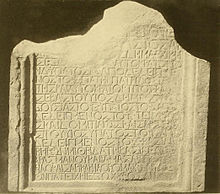Pharasmanes I of Iberia
| Pharasmanes I | |
|---|---|

Pharasmanes I is mentioned on Armazi stele of Vespasian
|
|
| King of Iberia | |
| Reign | 1 – 58 |
| Predecessor | Arshak II of Iberia |
| Successor | Mihrdat I of Iberia |
| Born | 1st-century BC Mtskheta, Kingdom of Iberia |
| Died | 58 AD |
| Spouse | daughter of Tigranes IV |
| Issue |
Mihrdat I of Iberia Rhadamistus Amazaspus |
| Dynasty | Pharnavazid dynasty |
| Father | Kartam of Colchis |
| Mother | daughter of Pharnavaz II of Iberia |
Pharasmanes I (Georgian: ფარსმან I) (died 58) was a king of Iberia. He plays a prominent role in the historian Tacitus’ account of policy and campaigns in the eastern Roman Empire under Tiberius, Claudius and Nero. According to Cyril Toumanoff, Pharasmanes was a member of the third Pharnavazid dynasty and reigned from 1 to 58.
As allies of Rome, his brother Mithridates was installed as king of Armenia by Roman emperor Tiberius, who invaded Armenia in 35. When the Parthian prince Orodes, son of Artabanus III of Parthia, attempted to dispossess Mithridates of his newly acquired kingdom, Pharasmanes led a large Iberian army and defeated the Parthians in a pitched battle (Tacitus, Annals. vi. 32-35).
At an unknown date, Pharasmanes married an unnamed Armenian princess of the Artaxiad dynasty. She was the daughter of the Artaxiad Armenian monarchs Tigranes IV and his sister-wife Erato. His Armenian wife bore him three sons: Mithridates I (Mihrdat), Rhadamistus, and Amazaspus (Amazasp), who is known from the Epigram of Amazaspos found in Rome.
Around 52, Pharasmanes instigated Rhadamistus, whose ambitious and aspiring character began to give him umbrage, to make war upon his uncle Mithridates, and supported him in his enterprise. After a short reign, Rhadamistus was in turn expelled by the Parthians in 55, and took refuge again in his father's dominions. The Romans had expressed their displeasure at the proceedings of Rhadamistus, and in order to curry their favor, Pharasmanes put his son to death. Pharasmanes was apparently succeeded by Mithridates (Mihrdat) I.
...
Wikipedia
